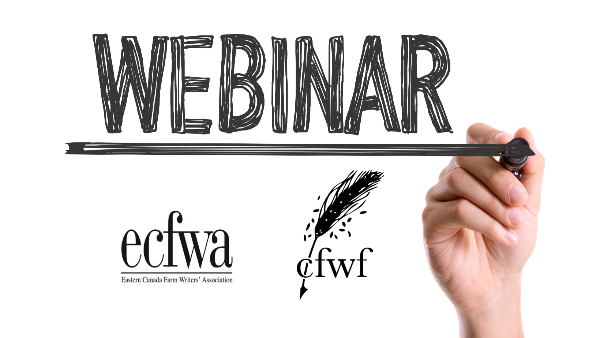Getting more agriculture stories into the media is the goal of many members of the Eastern Canada Farm Writers’ Association (ECFWA) – particularly for those who work in communications. Those on the journalism side of the equation are always looking for story ideas from the sector.
Providing some insights into this topic was the goal of the ECFWA’s May 14th webinar, which attracted more than 60 farm writer participants from across Canada. Moderated by ECFWA past president Matt McIntosh, the panel featured David Zura of CityNews and Ed White with Reuters.


For Zura, who studied journalism, it was a job with fastener supplier Fastenal in Windsor that gave him his first real exposure to the agriculture world thanks to the crop, greenhouse and wine producers in southwestern Ontario.
From his first story on ice wine, Zura was struck by how visual and relatable farm stories can be — especially when tied to universal concerns like food prices, safety, and availability.
“It’s something we all need — everybody eats,” he said.
According to Zura, stories resonate best when they are human, visual, and timely. Personal stories in particular — like a family’s experience with a farm injury that he was entrusted to tell — outperform data alone and humanize numbers.
As well, for his audience, a story has to appeal to someone in Toronto but also be relevant to viewers in other parts of Ontario – and in the fast-paced world of TV news, access is everything. Deadlines are daily, and news teams are smaller than they used to be, so sources that are available quickly and reliably, even if just for a 10-minute call, are very important.
White started his career with local newspapers in Ontario and western Canada before spending three decades with The Western Producer. Now, as Canada’s agriculture reporter at global wire service Reuters, his beat has shifted from a farmer-first lens to an international one: what the world wants to know about Canadian agriculture.
“People care about Canadian oil and gas, lentils, potash, canola, and cattle. But to make readers care, they need to see a person in the story — not just the policy,” he said.
He stressed that agriculture stories must connect beyond the industry. For instance, a shrinking cow herd becomes a story about rising beef prices.
“You have to explain why it matters to people who aren’t farmers,” he added.
What helps get ag stories into mainstream media?
- Quick access to real people who can speak authentically and clearly about issues.
- Strong visuals that help stories stand out on screens and in feeds.
- Human angles — relatable stories with emotion and stakes.
- Help connecting dots for urban audiences: what’s happening in fields impacts grocery stores, prices, and daily life.
What doesn’t work?
- Generic press releases – “we need real people saying real things”
- A single spokesperson – different voices make stories more interesting
- Slow replies – deadlines are short in mainstream media and even shorter in the wire service world
- Overly technical or “aggie” language that non-farm audiences won’t understand.
A recording of the webinar will be available shortly in the members-only section of the ECFWA website.





Leave a Reply
You must be logged in to post a comment.